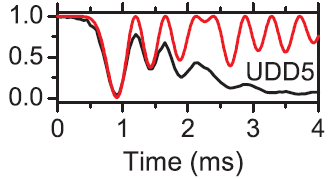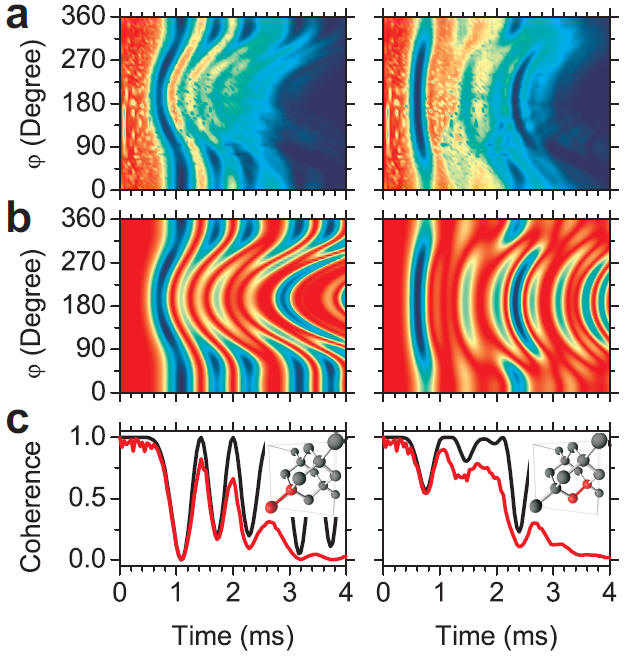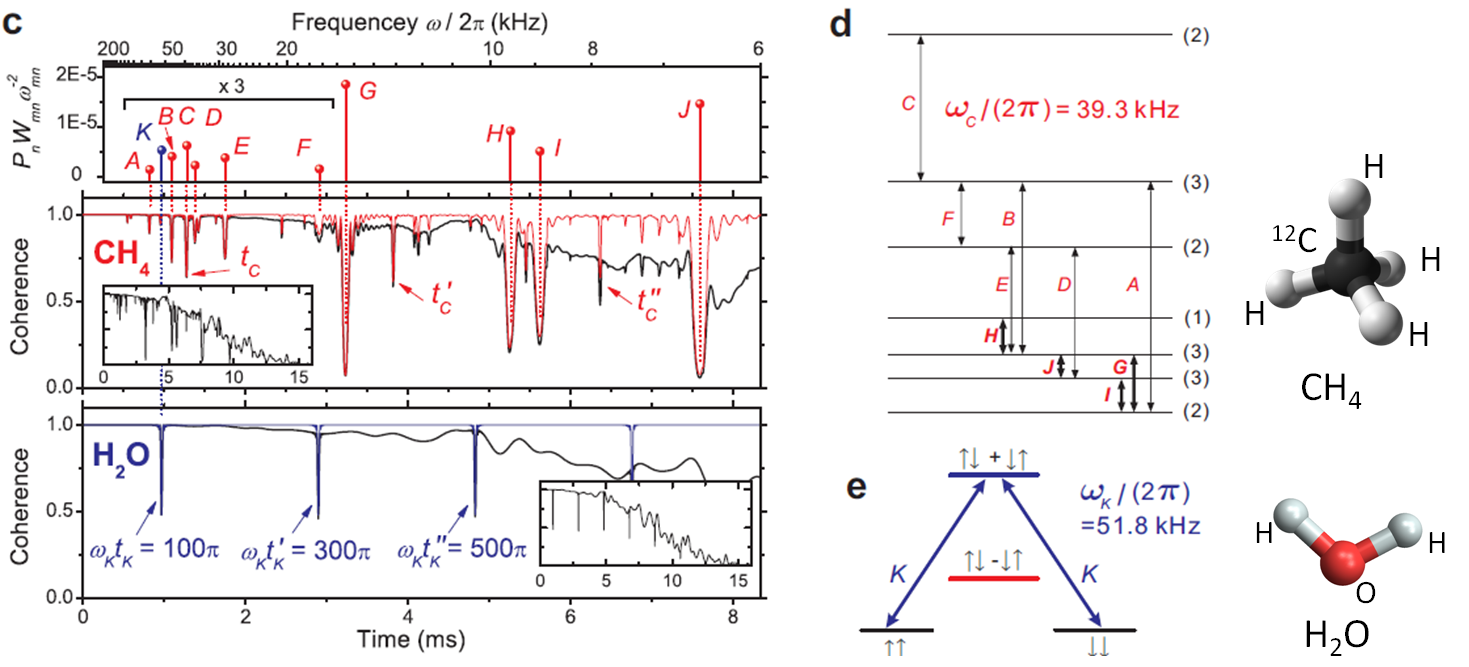Magnetometry: Toward single-molecule NMR and single-nucleus sensing
Nuclear magnetic resonance (NMR) has numerous applications in
medicine (such as in the well-known magnetic resonance imagining
technology), biology, chemistry, materials science, physics, etc.
This technology is still undergoing fast development. The most
important perspective is to push the sensitivity to the
single-molecule level to realize imaging resolution to the nanometer
or even atomic scale. Moreover, in the recent 15 years, scientists
are considering nuclear magnetic resonance for quantum computing.
However, magnetic dipoles of nuclear spins are extremely weak, and
only a large amount of molecules can produce detectable signals.
This difficulty limits the imaging resolution and makes large-scale
nuclear spin quantum computing an impossible mission.
General idea

Detection of single nuclear spin clusters and single-molecule NMR are possible by cascade amplification of the weak signals/noises from the clusters/molecules
Key points:
-
Detection of single photons is matured technology. A photon has energy much higher than room temperature and therefore the signal-to-noise ratio is large.
-
ODMR (optically detected magnetic resonance) can measure spin coherence of a single electron, if the optical transitions distinguish the spin states (by selection rules).
-
ODMR therefore measures a single nuclear spin if it is strongly coupled to the electron spin (> MHz coupling).
-
Distant nuclear spins or single molecules (with kHz coupling to the electron spin), however, usually cause a broaden noise spectrum and induce decoherence of the electron spin.
-
If two or more nuclear spins are strongly coupled to each other (with coupling ~ kHz, e.g.) to form a cluster, they have chracteristic flip-flops between themselves. This may cause fingerprint oscillations onto the decoherence profile of the electron spin, which can be used to identify the nuclear spin cluster.
-
The weak noises due to nuclear spin transitions in single molecules can be greatly enhanced by many-pulse dynamical decoupling (see details below). If the transitions have frequencies higher than the noise spectrum due to the background nuclear spins, the electron spin coherence will present fingerprint dips corresponding to NMR of the molecules.
Nitrogen-vacancy center in diamond
|
Features of negatively charged NV centers in diamond:
The electron spin of NV centers in high-purity (Type IIa) diamond has long coherence time (~millisecond), and there is very sensitive to weak magnetic noises. Good candidate for nano-magnetometry.
Figure: Structure (top) and optical and spin transitions of an NV center in diamond |
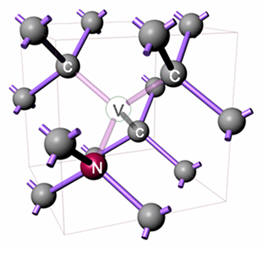 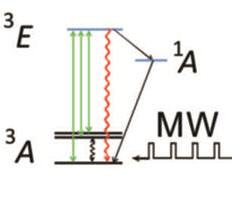 |
Atomic-scale magnetometry of distant C-13 dimers
| Among the
background of C-13 nuclear spins in
diamond, the nuclear spin
fluctuations are mostly featureless.
But if two or more c-13 are closely
located to each other (not necessary
close to the NV center), like the
dimer shown in the right figure, the
interaction within the C-13 cluster
can be comparable to the hyperfine
interaction with the NV center, and
the characteristic transitions of
the cluster can induce coherent
oscillations on the NV center spin
decoherence profile . Such
characteristic oscillations are
sensitive to the location and
orientation of the cluster. The dependence of the coherent oscillations on the external field and the dynamical decoupling control constitutes the fingerprint of a nuclear spin cluster, by which a cluster can be identified with atomic scale resolution and single-nucleus sensitivity. Right figure (bottom) shows the fingerprint oscillation induced by a dimer as the field direction [Zhao et al, Nature Nanotech. (2011)]. When the dimer is shifted by one atom site (along [110] direction), the coherent oscillations are significantly different. Figure: Top-left, a C-13 dimer; top-right, coherent oscillation due to a C-13 dimer onto the NV center spin coherence; bottom, NV center spin coherence versus time and external field direction, in which (a) contains both background and the dimer contribution, (b) contains only dimer contribution and (c) is the cross-section plot. |
|
Single-molecule NMR by many-pulse dynamical decoupling
| By dynamical decoupling (DD), the NV center spins is flipped repeatedly by microwave pulses. Effectively, the field felt by the electron spin is inversed repeatedly. This tends to cancel the noises (by a modulation function alternating between 1 and -1) and prolongs the NV center spin coherence time. But when a noise has the same frequency as the modulation (or an integer multiple), the noise is amplified instead. Thus, a relatively high-frequency noise (10~100 kHz) from NMR transitions of single molecules, though extremely weak, can induce sharp dips in the NV center spin coherence under protection of many-pulse DD. |
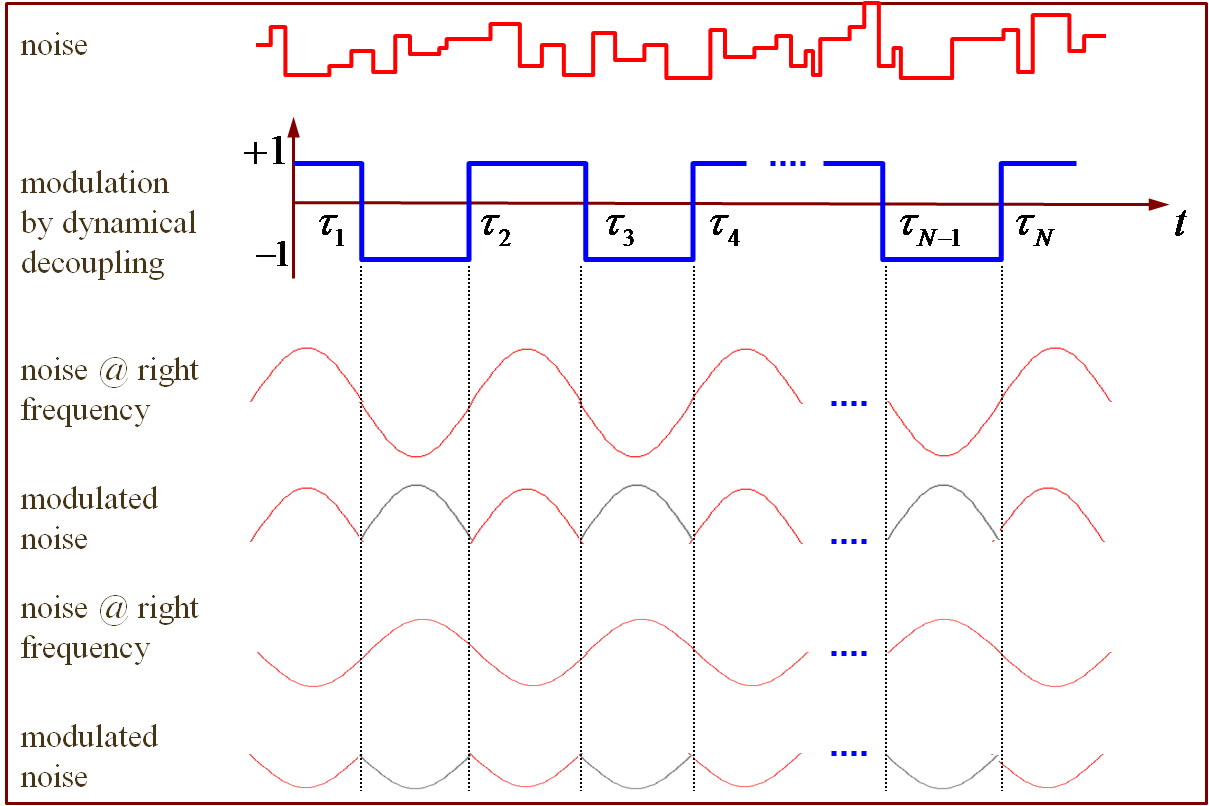 |
|
|
Figure [from Zhao et al, Nature Nanotech. (2011)]: Coherence of an NV center spin under 100-pulse periodic DD control. 5 water or methane molecules are on the diamond surface. The center is 10 nm below the surface. No external magnetic field is applied. |
|
ODMR of NV center spin coherence under many-pulse DD can detect NMR of single molecules (e.g., 5 water or methane molecules in the above figure). Features:
|
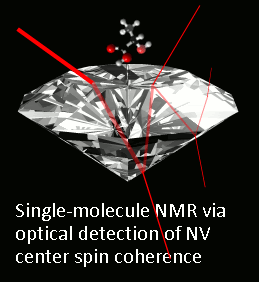 |
Last update: 12th Mar 2011
© R. B. Liu, Department of Physics, The Chinese University of Hong Kong. All rights reserved.


